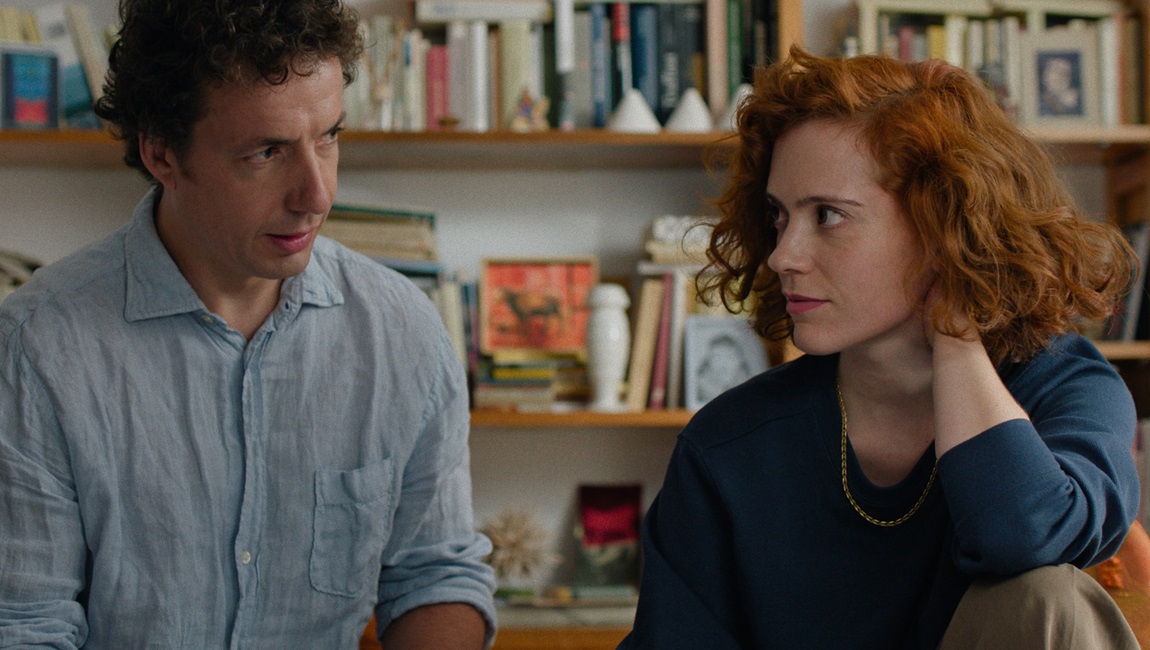When first introduced at the beginning of Jonás Trueba’s The Other Way Around, a couple, Ale (Itsaso Ariana) and Alex (Vito Sanz), have already decided to separate after some 15 years of marriage. Although we never learn the precise reasons for the decision, they repeatedly say that it was mutual and that they are on good terms. Indeed, rather than break up quietly, the pair resolves to throw a party, inspired by an oft-repeated mantra by Ale’s father that people would do better to celebrate separations than unions. Much of the film thus comprises conversations where Ale and Alex, sometimes separately, sometimes together, tell friends and family that they are separating, while at the same time inviting them to the forthcoming celebration.
This story hook alone is a gag worthy of a classic Hollywood screwball, eliciting reactions that run the gamut from bewilderment to tears to assertions that the couple will inevitably get back together. If the film also seems to suggest the makings of what Stanley Cavell once termed the Hollywood comedy of remarriage, where the central thrust is not to get a couple together, but to get them back together, together again, this is no coincidence. Already referenced in Trueba’s earlier The August Virgin (2019), Cavell’s genre study, Pursuits of Happiness, is even more prominently referenced here, when Ale’s father gives the book to her to read after she breaks the news that she and Alex are separating. Audio from The Philadelphia Story (1940), one of the seven remarriage comedies Cavell discusses, intrudes at one point, while a key musical theme from the film recurs toward the end. Even before these direct references, though, the potential for a reunion is already an active possibility. Despite their protestations to the contrary, neither Ale nor Alex ever seem entirely certain of their decision to separate. The decision to plan a party celebrating it, though, transforms this transitional period in their relationship into a kind of comedy of escalation, where any lingering uncertainty is covered up by doubling down.
Had Trueba done nothing but run with this setup, he would have done a lot. But he does more than that. Perhaps understanding that to simply engage with a tradition of classic Hollywood is to risk stylistic anachronism, he introduces a meta-fictional dimension that continually reconfigures our sense of the film’s central relationship — and, indeed, the film itself. We eventually learn that Ale and Alex work together professionally — she as a filmmaker, he as an actor. But apart from the personal complications that would result from their separation, Trueba adds a meta-fictional layer that suggests that we are seeing not just their present-tense break-up, but the film that Ale is making about it, in which Alex is featured — an impression that only intensifies throughout the film. Early on, the couple part ways after looking at a new apartment: we see Alex take a walk in the city, while Ale heads to the editing room, where, confoundingly, the footage of Alex walking shows up on her screen. In later sequences, we get the sense that what we are seeing, far from being a completed drama, is a film in the process of being made, featuring conspicuous edits, reframings, and title card placeholders that would not otherwise make it into a final cut. Across the runtime, subsequent scenes recursively reconfigure our sense of previous ones, as if the structure of Chronicle of a Summer (1961) were transposed into a fictional key.
While this meta-fictional ploy might initially come across as unnecessary or over-clever, it gradually builds in significance and meaning. For one thing, The Other Way Around is, refreshingly, less about the creative process than the temporal dynamics involved in reflecting upon a relationship, or really any long-term event. For another, Trueba uses this reflexive play to reconcile two divergent influences: the remarriage comedies of classic Hollywood, already mentioned, as well as the films of Éric Rohmer, whose 1948 manifesto “For a Talking Cinema” has clearly made its mark on Trueba’s cinema. When Alex calls his mother to tell her of the separation, for example, we get a series of quick jump cuts, which are somewhat unexpected given the naturalistic behavioral ambiance and long-take setups of prior scenes, but which are more in keeping with the rhythms of a screwball gag. When the meta-fictional dynamic later comes to the fore, however, the jagged editing is retroactively given motivation — as if an editor were scrubbing through the footage from on set. In this way, Trueba manages to harmonize the rhythms of behavior and conversation we find in Rohmer’s films, with their unparalleled realism of image and sound, with the overt narrative interventions of a classical Hollywood movie. The result is a film that goes beyond mere pastiche, demonstrating that often, the most inventive works are often those which display a deep understanding of the traditions they derive from.
Published as part of Cannes Film Festival 2024: Dispatch 1.







